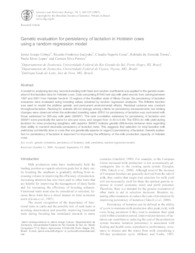Genetic evaluation for persistency of lactation in Holstein cows using a random regression model.
Genetic evaluation for persistency of lactation in Holstein cows using a random regression model.
Author(s): COBUCI, J. A.; EUCLYDES, R. F.; COSTA, C. N.; TORRES, R. de A.; LOPES, P. S.; PEREIRA, C. S.
Summary: A model for analyzing test day records including both fixed and random coefficients was applied to the genetic evaluation of first lactation data for Holstein cows. Data comprising 87045 test-day milk yield records from calving between 1997 and 2001 from Holstein herds in 10 regions of the Brazilian state of Minas Gerais. Six persistency of lactation measures were evaluated using breeding values obtained by random regression analyses. The Wilmink function was used to model the additive genetic and permanent environmental effects. Residual variance was constant throughout lactation. Ranking for animals did not change among criteria for persistency measurements, but ranking changes were observed when the estimated breeding value (EBV) for persistency of lactation was contrasted with those estimated for 305-day milk yield (305MY). The rank correlation estimates for persistency of lactation and 305MY were practically the same for sire and cows, and ranged from -0.45 to 0.69. The EBVs for milk yield during lactation for sires producing daughters with superior 305MY indicate genetic differences between sires regarding their ability to transmit desirable persistency of lactation traits. This suggests that selection for total lactation milk yield does not identify sires or cows that are genetically superior in regard to persistency of lactation. Genetic evaluation for persistency of lactation is important for improving the efficiency of the milk production capacity of Holstein cows.
Publication year: 2007
Types of publication: Journal article
Unit: Embrapa Dairy Cattle
Observation
Some of Embrapa's publications are published as ePub files. To read them, use or download one of the following free software options to your computer or mobile device. Android: Google Play Books; IOS: iBooks; Windows and Linux: Calibre.
Access other publications
Access the Agricultural Research Database (BDPA) to consult Embrapa's full library collection and records.
Visit Embrapa Bookstore to purchase books and other publications sold by Embrapa.

